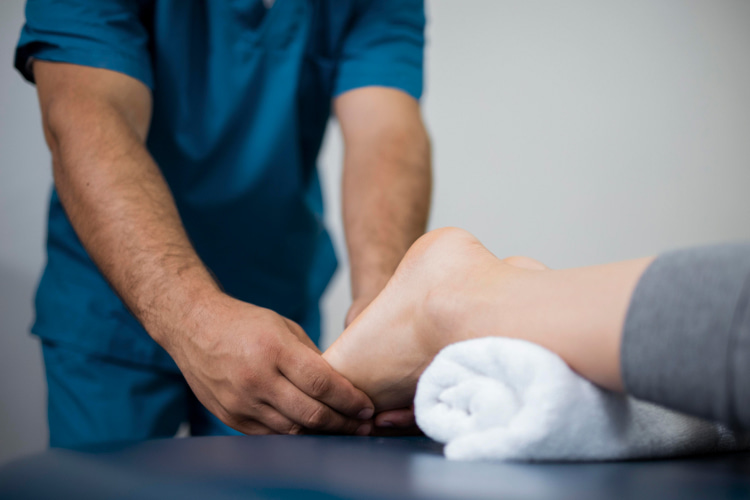Manual care is a way to make your muscles and bones healthier and feel better. One special part of this care is manual ankle corrections. It helps with ankle problems. They can come from improper alignment, getting hurt, or straining. These issues can make it hard to move around and enjoy life. This introduction talks about the important things to know about manual ankle adjustments. It explains how they work and what they can do to help.
Doctors look at your ankle carefully. And they use their hands to move things around to make it work better. This helps take away the pain and makes you feel less uncomfortable. They also try to fix the real reasons behind different ankle problems. We can understand how they help us move better, feel less pain, and be healthier. Whether you use this as your main treatment or as part of a bigger plan doesn’t matter! Knowing about chiropractic ankle adjustment is important if you want a way to make your ankle feel better without surgery.
Common Ankle Issues
Exploring common ankle issues helps us learn about the problems. Those can affect our ankles and make daily life harder. We’ll find out about things like sprains, arthritis, and tendonitis. They can make our ankles hurt. Looking at these problems helps us understand:
- The difficulties they bring.
- The ache they cause.
This will help us see how these ankle issues make moving, feeling good, and enjoying life tough.
Knowing about these common problems makes us realize how important it is to fix them for ankles.
Sprained Ankles
As our tests showed, sprained ankles are one of the most prevalent ankle injuries. They occur when the ligaments that support the ankle joint are stretched or torn. It’s due to sudden twisting or rolling movements. This can lead to pain, swelling, and limited range of motion. Ankle sprain chiropractic treatment helps in restoring:
- Proper alignment.
- Function to the joint.
It aids in the healing process and preventing chronic issues.
Ankle Arthritis
It involves the gradual deterioration of the cartilage within the ankle joint. It leads to pain, stiffness, and reduced mobility. Manual care can offer relief by gently manipulating the joint. It improves its alignment and promotes better circulation. This potentially slows down the progression of arthritis and enhances joint function.
Achilles Tendonitis
Achilles tendonitis is characterized by inflammation of the Achilles tendon. It connects the calf muscles to the heel bone. This condition often results from overuse, leading to pain and discomfort. Manual care can address misalignments in the ankle that contribute to uneven stress on the tendon. It aids in the healing process and preventing recurrence.
Plantar Fasciitis
Plantar fasciitis involves inflammation of the plantar fascia. It’s a ligament that connects the heel bone to the toes. This condition leads to sharp heel pain, especially during the first steps in the morning. Ankle sprain chiropractic treatment can help correct misalignments. They may contribute to abnormal strain on the plantar fascia. And manual care alleviates pain and promotes proper healing.
Ankle Instability
After conducting experiments we found out that ankle instability often follows a previous ankle injury. And it’s characterized by recurrent feelings of the ankle “giving way.” Manual adjustments can enhance joint stability. It improves alignment and restores proper mechanics. This reduces the risk of further injuries and promotes better ankle function.
Subluxations
Subluxations refer to slight misalignments of the ankle joint. They can result from trauma or repetitive stress. These misalignments can lead to pain, restricted movement, and muscle imbalances. Ankle sprain chiropractic treatment aims to restore normal joint alignment. It allows for improved mobility and reduces discomfort.
Nerve Compression
Nerve compression in the ankle region can lead to pain, tingling, and numbness. Manual adjustments can help ease nerve compression. It addresses misalignments that may be putting pressure on the nerves. Thus it promotes nerve health and reduces associated symptoms.
Chronic Ankle Pain
Chronic ankle pain may result from unresolved injuries, long-term misalignments, or degenerative conditions. Manual ankle adjustments can provide relief. It addresses underlying joint issues. This improves circulation and facilitates the body’s natural healing processes.

Chiropractic Ankle Adjustment Steps
Exploring manual ankle corrections reveals a structured process to:
- Address ankle discomfort.
- Improve musculoskeletal health.
We’ll uncover the systematic steps involved. It includes patient assessment, diagnosis, corrections procedure, and post-care. This will provide a comprehensive understanding of how doctors manage ankle health.
Through this block, we’ll see how these adjustments are customized for individuals. We will learn about enhancing joint function, relieving pain, and promoting mobility. Understanding these steps offers insight into how manual ankle adjustments fit within a holistic approach to wellness.
Patient Assessment and Physical Examination
Before performing ankle corrections, sprained ankle chiropractors begin by assessing the patient’s condition. This includes a thorough physical examination of:
- The ankle joint.
- Surrounding tissues.
- The patient’s posture.
Doctors look for misalignments, signs of inflammation, restricted movement, and other factors. They might be contributing to the ankle problem. This assessment helps the doctor understand the specific issues.
Diagnosis and Treatment Plan
Based on the assessment findings, the sprained ankle chiropractor forms a diagnosis. They determine the underlying causes of the ankle problem. Whether it’s due to misalignment, muscle tension, or other factors. With this diagnosis, a personalized treatment plan is created. The plan outlines the goals, the techniques to be used, and the expected number of manual sessions. Clear communication with the patient ensures that they understand the process. And this ensures they are comfortable with the proposed treatment.
Ankle Adjustment and Post-Adjustment Care
Our data show that the actual ankle correction involves hands-on manipulation of the ankle joint. The doctor applies controlled pressure to specific areas of the joint. It aims to restore proper alignment and improve joint function. These corrections may involve gentle stretches, quick movements, or sustained pressure. It depends on the patient’s condition and the doctor’s approach.
Post-adjustment care is equally important. Doctors often guide how to care for the ankle following the therapy. This includes ice or heat therapy recommendations, gentle exercises, and avoiding activities.
Benefits of Chiropractic Ankle Adjustment
Manual ankle adjustments are an important part of holistic healthcare. It can address various ankle concerns. Skilled doctors perform these adjustments, providing several advantages for ankle health and well-being. In this block, we will explore the diverse benefits of manual ankle adjustments.
We’ll delve into how they improve mobility. You will know how to enhance joint function, relieve pain, and prevent issues. This block reveals how corrections offer a non-invasive method for optimizing health. We will look at the holistic principles of manual care. And we’ll see how these adjustments fit into a broader perspective of wellness.
Non-Invasive Approach
Manual ankle adjustments offer a gentle way to improve ankle health without surgery. Sprained ankle chiropractors use hands-on techniques to help the ankle feel better and work properly. This means no cuts, no anesthesia, and no long recovery times. People who prefer natural ways of healing often find these adjustments appealing.
Improved Mobility
One great thing about manual care is that it helps you move better. Your ankle may not move well because of problems like misalignment or tight muscles. Then doctors can help fix that. Doctors make specific adjustments. And they help your ankle feel less stuck, so you can move around easier. This is useful for everyday activities, exercise, and playing sports.
Enhanced Function
Sprained ankle chiropractors don’t just help your ankle. They can also make your whole lower body work better. When your ankle is in good shape, it can help your muscles and bones work together better. This means your body feels stronger, and you don’t strain your muscles as much. Plus, your balance and coordination can improve too. It is important for comfort.
Prevention of Recurrence
Doctors not only fix what’s hurting now, but they also stop future issues. They fix misalignments and other problems. Doctors help prevent ankle troubles from coming back. This means you’re less likely to get hurt again or feel discomfort in the long run. Regular Manual care can help keep your ankles healthy. So you can avoid more ankle problems later.
Looking at the Big Picture
Manual care is about looking at the whole body, not just one part. When sprained ankle chiropractors work on your ankle, they also think about how it connects to the rest of your body. This approach helps them give you better care. They think about how your ankle, muscles, and other joints work together. This way, you get more complete and lasting results

Choosing a Right Chiropractor for Ankle Pain
Selecting the appropriate doctor for ankle pain is crucial. It’s to receive effective and safe care. The key considerations when choosing a doctor are:
- Qualifications and Credentials. Verify that the doctor holds the necessary qualifications and they’re licensed. Look for affiliations with reputable manual care associations. It’s a sign of their commitment to professional standards.
- Specialization and Experience. Seek a chiropractor for ankle pain with experience in treating ankle-related issues. Specialization in musculoskeletal and sports manual care can state their expertise.
- Patient Reviews and Testimonials. Read reviews and testimonials from patients who have undergone ankle pain treatment. This provides insights into the quality of care, bedside manner, and patient satisfaction.
- Referrals. Seek recommendations from healthcare professionals, friends, or family members. Ask those who have had positive experiences with manual care for ankle pain. Personal referrals can help you find a trusted practitioner.
- Insurance Coverage. Check whether the doctor accepts your health insurance or offers flexible payment options. Understanding the financial aspect of treatment is important for planning your care.
Bottom Line
Understanding manual ankle corrections is essential for optimizing musculoskeletal health and well-being. They offer a non-invasive approach to addressing various ankle issues. Improving alignment, joint function, and mobility provides relief from aches and discomfort.
Manual ankle corrections are usually personalized for each individual. It considers their health history and daily life. Selecting the right chiropractor for ankle pain is crucial. Focus on qualifications, specialization, patient reviews, and communication skills.
FAQ
Podiatrist or chiropractor for foot pain?
Both podiatrists and chiropractors can help with foot pain. Podiatrists specialize in foot issues, while chiropractors focus on musculoskeletal health. Choose based on the cause of your pain.
Do chiropractors check ankles?
Yes, chiropractors assess and treat ankle problems using hands-on techniques. They consider how the ankle connects with the rest of the body.
When to see a chiropractor for foot pain?
Consider a chiropractor if foot pain involves musculoskeletal issues like misalignments. Persistent or interfering pain might warrant a chiropractic evaluation. But specific foot conditions may need a podiatrist’s expertise. Always consult a professional for guidance.


Related posts
Today is an era dominated by digital conveniences and desk-bound occupations. So, the effects of a sedentary lifestyle have emerged as a pervasive concern.
Our guide aims to equip people with the knowledge to understand the intricacies of internal injuries. They are arising as a result of car accidents. Join us on this informative trip.
Beyond merely treating injuries, chiropractors work to enhance the body's biomechanics. It allows sportsmen to move more potently and reduces the risk of future injuries.